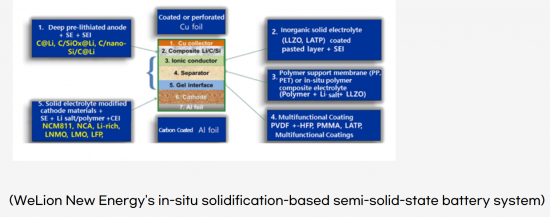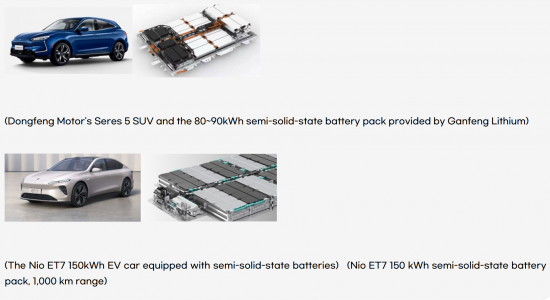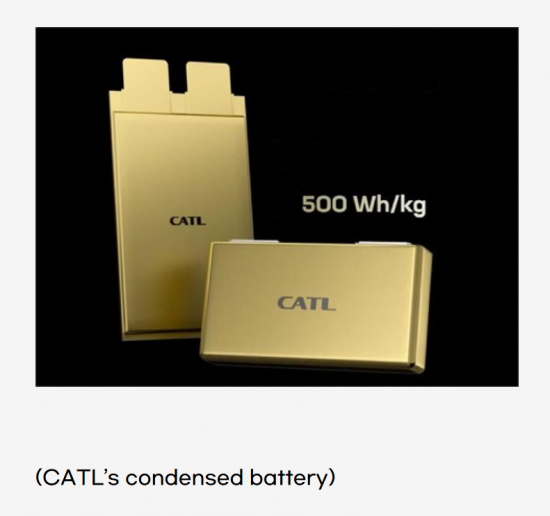 |
市场调查报告书
商品编码
1473268
半固态电池技术:发展及未来展望<2024> Semi-Solid Battery Technology: Development and Future Prospects |
||||||
各大电池製造商和汽车整车厂都计划量产固态电池。然而,这些电池的大规模生产预计需要五到十年的时间。同时,由于半固态电池相对于传统锂离子电池(LiB)具有潜在的安全性、寿命和成本优势,人们对半固态电池的兴趣日益浓厚。由于这些期望,许多公司,尤其是中国的公司,都宣布了大规模生产半固态电池的计画。
半固态电池是介于液态电池和固态电池之间的中间产品。半固态电池在电池内加入一些电解质以增强介面。与液体电池相比,半固体电池可以最大限度地减少材料体系的变化,利用隔膜和液体电解质,并减少液体电解质的体积。这种减少可以提高电池的能量密度和安全性。此外,半固态电池的製造流程与传统锂离子电池技术和设备紧密相连。
在半固态电池中,添加液体可以增强复合材料中的离子传输,而不影响电子传输,并改善电极的电化学性能。这需要透过固/液界面的低电阻离子传输。最近的原位聚合技术已被用来透过固化半固体电池的原始液体成分来减少液体含量。
有机/无机复合固态电解质是最受欢迎的半固态电池形式之一,结合了有机和无机固态电解质的优点。这些复合材料通常由氧化物固体电解质和聚合物电解质组成,具有优异的拉伸强度和机械性能、良好的加工性能和足够的离子电导率,使其适合大规模生产。
半固态电池发展主要由CATL、WeLion、Qingtao Energy、Ganfeng Lithium、Guoxuan、Farasis、Tailan等中国企业推动。此外,LGES、Factorial Energy、SES、ProLogium也在独立或与汽车 OEM 厂商合作开发这项技术。
2023年上海车展上,CATL带着期待已久的凝聚式电池亮相,引起了业界的关注。这项突破性技术采用高功率仿生凝聚电解质,并具有自适应微观网路结构。这些技术创新提高了动态性能和锂离子传输效率,使电池能量密度达到惊人的500Wh/kg,超过了传统锂离子电池。此外,CATL的创新也延伸到稳定性和产能,确保为未来电动车提供可靠且可扩展的解决方案。
固态电池的应用已经开始,NIO ET7搭载WeLion 360Wh/kg半固态电池,容量为150kWh,续航里程达到1145km,超过传统电池。计划于 2024 年 4 月开始量产。
根据SNE Research预测,2030年全球固态电池产能预计将达到约168GWh,2035年将达300GWh。预计整体电池市占率将从2030年的约5.7%达到峰值,到2033年约6.55%,然后随着固态电池的普及,到2035年再次下降至5.7%。
本报告分析了全球半固态电池的技术和市场趋势,提供了半固态电池的概述、特点和分类,提供了与全固态电池的技术比较,并对其在电动车中的应用进行了展望(电动汽车)等。我们收集并提供未来技术发展和市场成长方向以及主要公司的核心专利等资讯。
本报告的好处:
- 1.半固态电池最新趋势详解
- 2.主要电池製造商和汽车整车厂详细覆盖
- 3.瞭解竞争格局:半固态电池与固态电池的比较
- 4.半固态电池发展历程及现状
- 5.半固态电池相关主要专利分析




目录
第1章 半固态电池发展趋势
- 全固态电池实际应用面临的课题
- 全固态电池製造业不成熟
- 半固态电池:对产业链的影响
- 改进包装流程:中间阶段和后期阶段
- 固体电解质膜形成工艺
- 核心材料系统创新
- 半固态电池成本降低
- 锂金属负极的用途
- 规模经济的需要
- 半固态电池:主要优点
第2章 固态电池、半固态电池、混合电池的分类
- 固体电解质的类型
- 电解质体系的分类
- 固体电解质的分类:优点和缺点
- 混合电解质的类型
- 混合电解质特性
- 杂化无机聚合物复合电解质(IPC)
- 有机/无机杂化固体电解质
第3章 半固态电池用聚合物/无机复合电解质
- 概述
- 介绍
- 锂离子电导率
- 电化学稳定性
- 抑制树突
- 接触稳定性
- 聚合物/无机复合电解质填料
- 聚合物/无机复合电解质的组成
- 惰性填料
- 活性填料
- 聚合物/无机复合电解质的合成
- 结论与总结
第4章 全固态电池与半固态电池详细分析
- 全固态/半固态电池的优点(能量密度)
- 全固态/半固态电池的优点(安全性)
- 半固态电池的缺点
- 半固态电池的成本及未来前景
- 全固态电池/半固态电池相关政策:依国家划分
- 依应用划分的全固态/半固态电池市场
- 半固态电池的使用趋势
- 氧化物固体电解质产能(分公司)
第5章 半固态电池:电动车的最佳解决方案?
- 半固态电池及其他电池
- 半固态电池MP产业链
- 正极/负极材料
- 固体电解质
- 电动汽车市场
- 市场分析(中国市场)
第6章 半固态锂电池的发展:中间层的应用
- 分析总结
- 互动企业的角色
- 将 Ag-C 复合材料整合到 LLZTO 中
- 引入附加层
- 强化银附着力
- 锂金属电池特性分析
- 电化学电池
- LLZTO的电化学性能
- Li-Ag-C/Ag/LLZTO/IL-LCO 电池
- 结论与讨论
第7章 固态电池混合介面 (SLEI)
- SLEI(固液电解质界面)的定义
- 锂离子电池和固态电池的区别
- 混合固体电解质/液体电解质(SE/LE)系统
- SLEI 和 SEI 的异同
- 氧化物混合系统
- 硫化物基混合系统
- 纯溶剂的研究
- 液体电解质的电化学性质
第8章 使用准固态电解质的高效能锂金属电池:MOF(金属有机框架)概述
- 分析总结
- 准固体电解质的生产
- CuBTC MOF 作为主体材料
- 准固体电解质的物理化学性质
- 准固态电解质与电极的相容性
- NCM-811//锂软包电池的电化学性能
- 结论
第9章 使用准固态电解质的锂硫电池
- 锂硫 (Li-S) 电池概述
- 固态锂硫电池
- 工作原理
- 充电/放电曲线
- 离子传导机制
- 技术问题
- 电解质材料设计策略
- 聚合物电解质的应用
- 凝胶/半固态聚合物电解质
- 固态聚合物电解质
- 无机固体电解质
- 硫化物固态电解质
- 氧化物固体电解质
- 混合电解质
- 无机-有机复合电解质
- 无机固液电解质
- 结论与展望
第10章 半固态电池产业发展趋势
- 我国半固态电池现状
- 中国全固态电池研发(R&D)
- 各公司投资状况
- 中国固态电池前景
- 下一代电池的商业化
- 目前 LiB 改进的局限性
- 半固态电池的持续发展
- 提高对半固态电池的认识
- 固态电池生产(2026年后)
- 日本企业:延迟3-7年
- 全球半固态电池发展趋势
- 正负极材料的发展趋势
- 电池结构解模组化
- 半固态电池开始量产
第11章 半固态电池生产企业及企业
- LGES
- SK On
- WeLion
- BAK
- CATL
- NIO
- KAERI(Korea)
- ProLogium
- SES
- Factorial Energy
- KIERKorea)
- imec
- Qingtao Energy
- Ganfeng Lithium
- Yiwei Lithium Energy (EVE)
- Guoxuan Hi-Tech
- Farasis Energy
- SVOLT
- SEMCORP
- NGK
- Kyocera
- Talent New Energy
第12章 半固态电池市场展望
- 中国半固态电池产业现状
- 半固态电池产业的历史
- 中国半固态电池相关政策
- 中国电动车半固态电池需求展望
- 中国半固态电池市场渗透率
- 全球半固态电池市场展望
第13章 半固态电池专利分析
- Korea Institute of Energy Technology
- Qingtao New Energy
- LGES
- Arkema
- Global Graphene Group Inc.
- WeLion New Energy
- Ganfeng Lithium
- Sion Power
- Factorial Energy
- StoreDot
- SVOLT
参考
Major battery manufacturers and automotive OEMs are planning to mass-produce all-solid-state batteries. However, large-scale production of these batteries is expected to take 5-10 years. In the meantime, there's increasing interest in semi-solid-state batteries due to their potential safety, longevity, and cost advantages over conventional lithium-ion batteries (LiBs). This anticipation is driving many companies, especially in China, to announce mass production plans for semi-solid-state batteries.
Semi-solid-state batteries serve as a transitional product between liquid-state and solid-state batteries. They incorporate a portion of electrolyte within the battery to enhance the interface. Compared to liquid-state batteries, semi-solid-state batteries necessitate minimal alterations to the material system, utilize separators and liquid electrolytes, and can decrease the volume of liquid electrolyte present. This reduction can enhance battery energy density and safety. Moreover, the manufacturing processes for semi-solid-state batteries closely align with traditional lithium-ion battery techniques and equipment.
In semi-solid-state batteries, the addition of a liquid can enhance ion transport through the composite material without compromising electron transport, leading to improved electrochemical performance of the electrodes. This requires a low-resistance ion transport through the solid/liquid interface. Recent in-situ polymerization techniques have been employed to reduce the liquid content by solidifying the original liquid components of the semi-solid-state battery.
Organic-inorganic composite solid electrolytes, one of the most prevalent forms in semi-solid-state batteries, combine the advantages of both organic and inorganic solid electrolytes. These composite materials, typically consisting of oxide solid electrolytes and polymer electrolytes, exhibit exceptional tensile strength and mechanical properties, excellent processability, and adequate ion conductivity, making them suitable for large-scale production.
The development of semi-solid-state batteries is primarily being driven by Chinese companies, including CATL, WeLion, Qingtao Energy, Ganfeng Lithium, Guoxuan, Farasis, and Tailan. Additionally, LGES, Factorial Energy, SES, and ProLogium are also independently or collaboratively developing this technology with automotive OEMs.
At the 2023 Shanghai Auto Show, CATL unveiled its highly anticipated Condensed Battery, grabbing industry attention. This groundbreaking technology utilizes a high-power bionic condensed electrolyte and features an adaptive micro-level network structure. These innovations enhance dynamic performance and lithium ion transport efficiency, resulting in an impressive cell energy density of 500 Wh/kg, surpassing conventional lithium-ion batteries. Moreover, CATL's innovation extends to stability and production capabilities, promising a reliable and scalable solution for electric vehicles in the future.
The application of solid-state batteries has already begun, and the NIO ET7 equipped with WeLion's 360Wh/kg semi-solid-state battery, boasting 150kWh, achieved a range of 1145km, surpassing conventional batteries. It's reported that mass production started in April 2024.
According to SNE Research, global solid-state battery production capacity is expected to reach approximately 168GWh by 2030 and 300GWh by 2035. In terms of overall battery market share, it is projected to peak at around 6.55% in 2033 from approximately 5.7% in 2030, before declining to 5.7% again by 2035 as solid-state batteries are widely adopted.
The strong points of this report are as follows.
- 1. Detailed coverage of recent trends surrounding semi-solid-state batteries
- 2. Detailed coverage of major battery manufacturers and automotive OEMs
- 3. Navigating the Competitive Landscape: Semi-Solid-State Batteries vs. Solid-State Batteries
- 4. The development history and current status of semi-solid-state batteries
- 5. Analysis of key patents related to semi-solid-state batteries




Table of Contents
1. Semi-Solid-State Battery Development Trends
- 1.1. Commercialization Challenges for All-Solid-State Batteries
- 1.1.1. Immaturity of All-Solid-State Battery Manufacturing
- 1.2. Semi-Solid-State Batteries: Impact on the Industrial Chain
- 1.2.1. Modifications to the Packaging Process: Intermediate and Rear Stages
- 1.2.2. Solid Electrolyte Film Formation Process
- 1.2.3. Innovation in Core Material Systems
- 1.2.3.1. Polymer Systems
- 1.2.3.2. Oxide Systems
- 1.2.3.3. Sulfide Systems
- 1.2.3.4. Costs
- 1.2.3.5. Electrolyte
- 1.2.3.6. Anode Material
- 1.2.3.7. Binders
- 1.2.3.8. Pre-lithiation
- 1.2.3.9. Separators
- 1.2.3.10. Dry Electrode Process (DBE)
- 1.2.3.11. Industrialization Status of Semi-Solid Batteries
- 1.2.3.12. Gel-Type Solid Electrolyte
- 1.3. Reducing the Cost of Semi-Solid-State Batteries
- 1.3.1. Using Lithium Metal Anodes
- 1.3.2. Need for Economies of Scale
- 1.4. Semi-Solid State Batteries: Key Advantages
2. Classification of Solid-State, Semi-Solid-State, and Hybrid Batteries
- 2.1. Types of Solid Electrolytes
- 2.2. Classification of Electrolyte Systems
- 2.3. Classification of Solid Electrolytes and Their Pros and Cons
- 2.4. Types of Hybrid Electrolyte
- 2.5~7. Properties of Hybrid Electrolyte
- 2.8. Hybrid Inorganic Polymer Composite Electrolyte (IPC)
- 2.9~10. Organic-Inorganic Hybrid Solid-State Electrolyte
3. Polymer/Inorganic Composite Electrolytes for Semi-Solid-State Batteries
- 3.1. Overview
- 3.2. Introduction
- 3.2.1. Lithium Ion Conductivity
- 3.2.2. Electrochemical Stability
- 3.2.3. Dendrite Suppression
- 3.2.4. Contact Stability
- 3.3. Polymer/Inorganic Composite Electrolyte Fillers
- 3.3.1. Components of Polymer/Inorganic Composite Electrolytes
- 3.3.2. Inert Fillers
- 3.3.2.1. Oxide Fillers
- 3.3.2.2. Ferroelectric Fillers
- 3.3.2.3. Porous fillers
- 3.3.2.4. Other Inert Fillers
- 3.3.3. Active Fillers
- 3.3.3.1. Garnet-Type Solid Electrolytes
- 3.3.3.2. NASICON-Type Solid Electrolytes
- 3.3.3.3. Perovskite-Type Solid Electrolytes
- 3.3.3.4. Sulfide-Type Solid Electrolyte
- 3.3.4. Synthesis of Polymeric/Inorganic Complex Electrolytes
- 3.4. Conclusion and Summary
4. In-Depth Analysis of All/Semi-Solid-State Batteries
- 4.1. All/Semi-Solid-State Battery Advantage (Energy Density)
- 4.2. All/Semi-Solid-State Battery Advantage (Safety)
- 4.3. Semi-Solid-State Batteries Disadvantage
- 4.4. Semi-Solid-State Battery Costs and Future Outlook
- 4.5. All/Semi-Solid-State Battery Policies by Country
- 4.6. All/Semi-Solid-State Battery Application Market
- 4.7. Semi-Solid-State Battery Application Trends
- 4.8. Oxide Solid Electrolyte Production Capacity by Company
5. Semi-Solid-State Batteries: The Optimal Solution for EVs?
- 5.1. Semi-Solid-State Batteries vs. Other Batteries
- 5.2. Semi-Solid-State Battery Industry Chains
- 5.2.1. Cathode/Anode Materials
- 5.2.2. Solid Electrolytes
- 5.2.3. EV Market
- 5.2.4. Market Analysis (Chinese Market)
6. Quasi-Solid Lithium Battery Development: Interlayer Application
- 6.1. Research Overview
- 6.2. The Role of the Interplayer
- 6.3. Integrating Ag-C Composites into LLZTO
- 6.3.1. Introducing Additional Layers
- 6.3.2. Enhancement of Ag Adhesion
- 6.4. Analysis of Lithium Metal Cell Characteristics
- 6.4.1. Electrochemical Cell
- 6.4.2. .Electrochemical Performance of LLZTO
- 6.4.3. Li-Ag-C/Ag/LLZTO/IL-LCO Cell
- 6.5. Conclusion and Discussion
7. Solid-State Battery Hybrid Interface (SLEI)
- 7.1. Definition of SLEI(Solid-Liquid Electrolyte Interphase)
- 7.2. Difference between LIBs and All-Solid-State Batteries
- 7.3. Hybrid Solid Electrolyte/Liquid Electrolyte(SE/LE) Systems
- 7.4. Similarities and differences between SLEI and SEI
- 7.5. Oxide-Based Hybrid System
- 7.6. Sulfide-Based Hybrid System
- 7.6.1. Research on Pristine Solvents
- 7.6.2. Electrochemical Performance for Liquid Electrolytes
8. High-Efficiency Li Metal Batteries with Quasi-Solid Electrolytes (Introduction of MOFs)
- 8.1. Research Overview
- 8.2. Fabrication of Quasi-Solid Electrolytes
- 8.2.1. CuBTC MOF as a Host Material
- 8.2.2. Physicochemical Properties of Quasi-Solid Electrolytes
- 8.2.3. Compatibility of Quasi-Solid Electrolytes with Electrodes
- 8.2.4. Electrochemical Performance of NCM-811//Li Pouch Cells
- 8.3. Conclusion
9. Li-S Batteries with Quasi-Solid Electrolytes
- 9.1. Li-S Battery Overveiw
- 9.2. Solid-State Li-S Batteries
- 9.2.1. Operating Principle
- 9.2.2. . Charge/Discharge Profile
- 9.2.3. Ion Conduction Mechanisms
- 9.2.4. Technical Issues
- 9.3. Electrolyte Material Design Strategies
- 9.4. Polymer Electrolyte Applications
- 9.4.1. Gel/Quasi-Solid Polymer Electrolyte
- 9.4.2. Solid-Polymer Electrolyte
- 9.5. Inorganic Solid Electrolyte
- 9.5.1. Sulfide Solid Electrolyte
- 9.5.2. Oxide Solid Electrolyte
- 9.6. Hybrid Electrolyte
- 9.6.1. Inorganic-Organic Composite Electrolyte
- 9.6.2. Inorganic Solid-Liquid Electrolyte
- 9.7. Conclusion and Outlook
10. Semi-Solid-State Battery Industry Trends
- 10.1. The State of Semi-Solid-State Batteries in China
- 10.2. .All-Solid-State Battery R&D in China
- 10.3. Each Company's Investment Status
- 10.4. Outlook on All(Semi)-Solid-State Batteries in China
- 10.5. Commercialization of Next-Generation Batteries
- 10.5.1. Limitations in Improving Current LiBs
- 10.5.2. Continued Development of Semi-Solid-State Batteries
- 10.5.3. Growing Recognition of Semi-Solid-State Batteries
- 10.5.4. Solid-State Battery Production from 2026
- 10.5.5. Japanese Companies Lagging Behind by 3-7 Years
- 10.5.6. Global Trends in Semi-Solid-State-Batteries
- 10.5.7. Trends in Cathode/Anode Material Development
- 10.5.8. Demodularization of the Battery Structure
- 10.5.9. Mass Production of Semi-Solid-State Batteries Initiated
11. Semi-Solid-State Battery Manufacturers and Operations
- 11.1. LGES
- 11.2. SK On
- 11.3. WeLion
- 11.4. BAK
- 11.5. CATL
- 11.6. NIO
- 11.7. KAERI(Korea)
- 11.8. ProLogium
- 11.9. SES
- 11.10. Factorial Energy
- 11.11. KIERKorea)
- 11.12. imec
- 11.13. Qingtao Energy
- 11.14. Ganfeng Lithium
- 11.15. Yiwei Lithium Energy (EVE)
- 11.16. Guoxuan Hi-Tech
- 11.17. Farasis Energy
- 11.18. SVOLT
- 11.19. SEMCORP
- 11.20. NGK
- 11.21. Kyocera
- 11.22. Talent New Energy
12. Semi-Solid State Battery Market Outlook
- 12.1. Current Status of Semi-Solid-State Battery Industry in China
- 12.2. History of Semi-Solid-State Battery Industry
- 12.3. Policies for China's Semi-Solid-State Battery
- 12.4. China's Semi-Solid-State Battery Demand Outlook for EVs
- 12.5. Market Penetration Rate of Semi-Solid-State Batteries in China
- 12.6. Global Semi-Solid-State Battery Market Outlook
13. Patent Analysis of Semi-Solid-State Batteries
- 13.1. Korea Institute of Energy Technology
- 13.2. Qingtao New Energy
- 13.3. LGES
- 13.4. Arkema
- 13.5. Global Graphene Group Inc.
- 13.6. WeLion New Energy
- 13.7. Ganfeng Lithium
- 13.8. Sion Power
- 13.9. Factorial Energy
- 13.10. StoreDot
- 13.11. SVOLT








